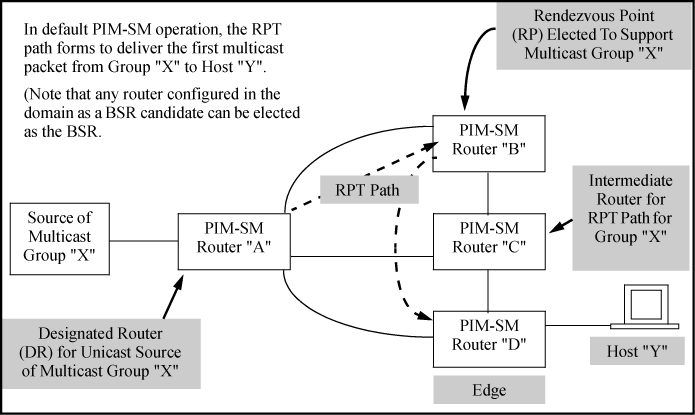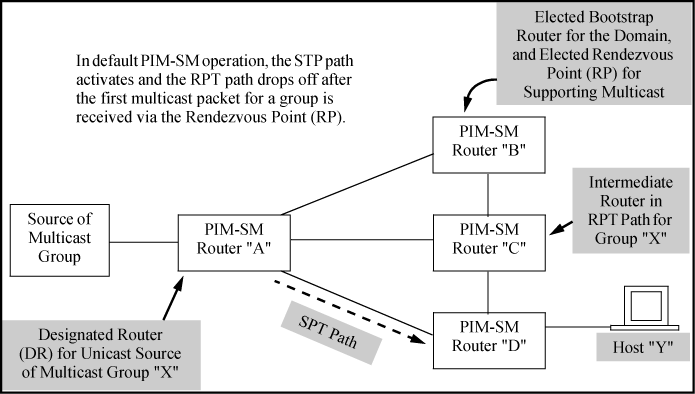Unlike PIM-DM, PIM-SM assumes that most hosts do not want to receive multicast traffic, and uses a non-flooding multicast model to direct traffic for a particular multicast group from the source to the VLAN(s) where there are multicast receivers that have joined the group. As a result, this model sends traffic only to the routers that specifically request it.
In a given PIM-SM domain, routers identified as DRs, RPs, and a BSR participate in delivering multicast traffic to the IP multicast receivers that request it. This approach avoids the flooding method of distributing multicast traffic (employed by PIM-DM) and is best suited for lower bandwidth situations.
The software supports the following operation to enable multicast traffic delivery within a PIM-SM domain:
-
From a pool of eligible DR candidates in each VLAN, one DR is elected for each VLAN interface having at least one PIM-SM router. In a multinetted domain, this DR supports multicast traffic from a source on any subnet in the VLAN.
-
From a pool of eligible BSR candidates in the domain, one BSR is elected for the entire domain.
-
From a pool of eligible C-RPs, one is elected to support each multicast group or range of groups allowed in the domain, excluding any group supported only by static RPs. The multicast groups allowed in the domain are determined by the aggregation of the groups allowed by the individually configured RPs and any static RPs. (Note that RP-Cs and static RP’s can be configured with overlapping support for a given set of multicast groups.)
When a DR in a VLAN receives traffic for a particular multicast group from a source on that VLAN, the DR encapsulates the traffic and forwards it to the RP elected to support that multicast group. The RP decapsulates the traffic and forwards it on toward the multicast receiver(s) requesting that group. This forms an RPT extending from the DR through any intermediate PIM-SM routers leading to the PIM-SM edge router(s) for the multicast receiver(s) requesting the traffic. (If the RP has no current join requests for the group, the traffic is dropped at the RP.)
SPTs are especially useful in high data-rate applications where reducing unnecessary traffic concentrations and throughput delays are significant. In the default PIM-SM configuration, SPT operation is automatically enabled. (The software includes an option to disable SPT operation.
In the default PIM-SM configuration, after an edge router receives the first packet of traffic for a multicast group requested by a multicast receiver on that router, it uses Reverse Path Forwarding (RPF) to learn the shortest path to the group source. The edge router then stops using the RPT and begins using the shortest path tree (SPT) connecting the multicast source and the multicast receiver. In this case, when the edge router begins receiving group traffic from the multicast source through the SPT, it sends a prune message to the RP tree to terminate sending the requested group traffic on that route. (This results in entries for both the RP path and the STP in the routing table.) When completed, the switchover from the RPT to a shorter SPT can reduce unnecessary traffic concentrations in the network and reduce multicast traffic throughput delays.
Note that the switchover from RPT to SPT is not instantaneous. For a short period, packets for a given multicast group may be received from both the RPT and the SPT. Also, in some topologies, the RPT and the SPT to the same edge router may be identical.
An alternate method to allowing the domain to use SPTs is to configure all of the routers in the domain to use only RPTs. However, doing so can increase the traffic load in the network and cause delays in packet delivery.
The edge router itself and any intervening routers on the active tree between the members (receivers) of a multicast group and the DR for that group, send periodic joins. This keeps the active route available for as long as there is a multicast receiver requesting the group. When a route times out or is pruned, the DR ceases to send the requested group traffic on that route.
Creating multiple domains enables a balancing of PIM-SM traffic within a network. Defining PIM-SM domain boundaries requires the use of PIM border routers (PMBRs), and multiple PMBRs can be used between any two domains.
|
|
|
![[NOTE: ]](images/note.gif) |
NOTE: The software described in this guide does not support PMBR operation for PIM-SM networks. |
|
|

